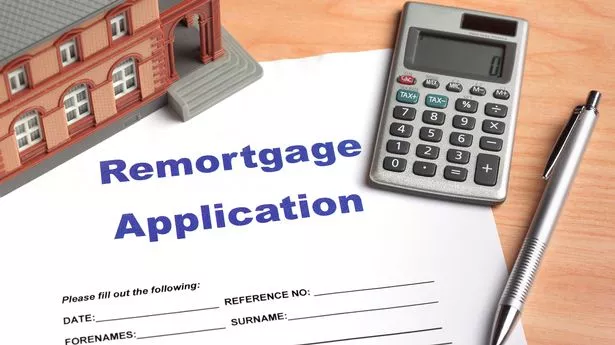What is Remortgage? Types, Rates and Remortgaging Process

Table of Contents
ToggleRemortgage Process
Many people need to be aware of the basic mortgage terms and, therefore, jump into a bad deal. A person aware of the ins and outs of the financial industry (concerning mortgage) of the United Kingdom can always have a good mortgage deal. A layman understands the term Mortgage as a loan from a financer like a bank to buy a new property, while this article will inform the readers about a concept called Remortgage. Let’s understand the process of remortgaging in a deeper sense.
Remortgage
A remortgage, or refinancing, involves replacing your existing mortgage with a new one on the same property. You use the funds from the new loan to pay off the original mortgage. This creates a new loan with potentially different terms, such as:
- Lower interest rate:This can significantly reduce your monthly payments and save you money on the total cost of your mortgage.
- Shorter or longer loan term:This can adjust your monthly payments and change the timeline for paying off your mortgage.
- Different loan type:For example, switching from an adjustable-rate mortgage (ARM) to a fixed-rate mortgage (FRM) for more predictability.
- Cash-out option:Accessing funds against your home’s equity for various needs like home improvement or debt consolidation.
Purpose:
People choose to remortgage for various reasons, including:
- Securing a lower interest rate:This is the most common reason, as it can lead to substantial financial savings.
- Freeing up equity:Cash-out refinancing allows you to tap into your home’s value for various needs.
- Consolidating debt:You can potentially combine other high-interest debts into a single mortgage with a lower rate.
- Shortening the loan term:Paying off your mortgage faster, but increasing your monthly payments.
- Changing loan type:Gaining more predictability with a fixed-rate mortgage or adjusting risk with an ARM.
Key Benefits:
- Lower interest rate:Potentially save thousands of dollars over the life of your mortgage.
- Improved cash flow:Reduced monthly payments can free up money for other expenses.
- Access to funds:Cash-out options offer resources for home improvements, debt consolidation, or other needs.
- More predictable payments:Fixed-rate mortgages offer security by locking your interest rate.
- Faster payoff:Shortening the loan term lets you own your home outright sooner.
Potential Drawbacks:
- Closing costs:You’ll typically incur fees for processing the new mortgage.
- Risk of higher interest rates:ARMs can expose you to potential rate increases.
- Increased debt:Cash-out options add to your overall debt burden.
- Longer payoff time:Extending the loan term increases the total interest paid.
- Credit score impact:Applying for a new loan can temporarily affect your credit score.
Eligibility and Qualifications:
Lenders consider various factors when assessing your eligibility for a remortgage:
- Credit score:Higher scores generally qualify you for better rates and terms.
- Income and employment:Stable and steady employment demonstrate your ability to repay.
- Loan-to-value ratio (LTV):The ratio of your remaining mortgage balance to your home’s value. Lower LTVs indicate more equity and greater eligibility.
- Property type and value:Different property types may have specific requirements.
- Debt-to-income ratio (DTI):This compares your monthly debt payments to your gross income. Lower ratios are more favorable.
Types Of Remortgages
Here are the different types of remortgages available in the UK:
1- Fixed-rate Remortgage:
With a fixed-rate remortgage, your interest rate will be fixed for a set period, typically between 2 and 10 years. This means that your monthly payments will remain the same throughout the fixed term, regardless of what happens to interest rates in the wider market. This can be a good option if you want to budget for your mortgage payments easily and avoid the risk of your payments increasing if interest rates rise.
2- Tracker Remortgage:
With a tracker remortgage, your interest rate will track a base rate, such as the Bank of England base rate, plus a set margin. This means your interest rate will go up and down in line with the base rate. This can be a good option if you expect interest rates to fall in the future, as your monthly payments will decrease. However, it is important to be aware that your payments could also increase if interest rates rise.
3- Discount Remortgage:
With a discount remortgage, you get a discount off the lender’s standard variable rate (SVR) for a set period. This can be a good option if you want a lower interest rate than the SVR, but you don’t want to be tied into a fixed rate for a long period. However, it is important to be aware that your interest rate could revert to the SVR after the discount period ends.
4- Offset Remortgage:
With an offset remortgage, you link your mortgage to a savings account. Any money you have in the savings account will offset your mortgage balance, which means that you will only pay interest on the difference. This can be a good option if you have a large amount of savings that you don’t need immediate access to.
5- Cash-out Remortgage:
With a cash-out remortgage, you borrow more money than you need to repay your existing mortgage. The difference is then paid to you in cash. This can be a good option if you need money for home improvements, debt consolidation, or other purposes. However, it is important to be aware that you will be borrowing more money and paying more interest overall.
6- Further Advance Remortgage:
With a further advance remortgage, you borrow more money from your existing lender without remortgaging to a new lender. This can be a good option if you need a smaller amount of money and want to keep your existing mortgage deal. However, it is important to be aware that the interest rate on a further advance may be higher than the interest rate on your original mortgage.
7- Buy-to-Let Remortgage:
A buy-to-let remortgage is designed specifically for properties that are rented out to tenants. The terms and conditions of buy-to-let remortgages can be different from those of residential remortgages, so it is important to shop around and compare deals before you remortgage.
8- Shared Ownership Remortgage:
Shared ownership is a government scheme that helps people buy a share of a property. If you own a shared ownership property, you may be able to remortgage it in the same way as you would remortgage any other property. However, there may be some additional restrictions or conditions that apply.
9- Right to Buy Remortgage:
Right to Buy is a scheme that allows council tenants to buy their homes at a discount. If you have bought your home under the Right to Buy scheme, you may be able to remortgage it in the same way as you would remortgage any other property. However, there may be some additional restrictions or conditions that apply.
10- Help to Buy Remortgage:
Help to Buy is a government scheme that helps people buy a new home. If you have bought a home under the Help to Buy scheme, you can remortgage it like you would remortgage any other property. However, there may be some additional restrictions or conditions that apply.
How does Remortgaging work?
Here are the key steps if you’re looking to remortgage:
- Research and Comparison:
- Explore different lenders and mortgage deals:Start by researching various lenders and the mortgage products they offer. Factors to consider include:Interest rates:Fixed, tracker, discount, etc., each with their own advantages and risks.
- Loan terms:Length of the loan, early repayment charges, and other conditions.
- Product fees:Valuation fees, arrangement fees, and other upfront costs.
- Utilize online comparison tools:These tools can provide a broad overview of available options, but remember to personalize your search with specific details.
- Seek professional advice:Consider consulting a qualified mortgage broker who can offer personalized guidance based on your financial situation and goals.
- Pre-approval:
- Apply for a preliminary assessment:This helps you understand your potential borrowing capacity based on your credit score, income, and property value.
- Provides valuable guidance:Knowing your estimated borrowing power allows you to focus on realistic options and budget effectively.
- Formal Application:
- Submit a formal application to your chosen lender:This typically involves providing personal information, financial documents (payslips, bank statements), and proof of address.
- Ensure accuracy and completeness:Double-check all information provided to avoid delays in the processing of your application.
- Valuation:
- The lender arranges a valuation of your property:This determines the current market value and your available equity (difference between the value and your remaining mortgage balance).
- Accuracy is crucial:An accurate valuation ensures you have access to the best possible remortgage options.
- Underwriting:
- The lender thoroughly assesses your application:This includes affordability checks, creditworthiness evaluations, and employment verification.
- Clear and complete documentation:Ensure all requested documents are provided promptly to facilitate the underwriting process.
- Offer and Acceptance:
- Upon approval, the lender presents you with a formal mortgage offer:This outlines the terms and conditions of the new loan, including interest rate, loan term, fees, and other charges.
- Carefully review and compare:Don’t rush into accepting the first offer. Compare with other options to ensure you’re getting the best deal.
- Solicitor Involvement:
- Appoint a solicitor specializing in remortgaging:They will handle legal aspects like conveyancing, title checks, and contract review.
- Seek qualified expertise:Choose a solicitor with experience in remortgaging transactions to ensure a smooth process.
- Completion:
- Once all legal conditions are met, the new mortgage funds are released:This pays off your existing mortgage, and the transfer of ownership is finalized.
- Ensure all requirements are met:Make sure all necessary documents and payments are submitted promptly to avoid delays.
- Consider Remortgage types:
- Fixed-rate:Offers a stable interest rate throughout the chosen term, providing predictability in budgeting.
- Tracker:Your interest rate tracks a base rate (usually the Bank of England base rate) plus a margin, offering potential flexibility but also exposure to rate changes.
- Discount:Provides a discount off the lender’s standard variable rate (SVR) for an initial period, followed by the SVR thereafter.
- Offset:Links your mortgage to a savings account, reducing the interest charged based on the funds held in the account.
- Cash-out:Allows you to borrow more than your remaining mortgage balance, accessing equity for various purposes.
- Further advance:Borrow additional funds from your existing lender without remortgaging to another provider.
When Should I Remortgage?
You might have signed up for an excellent deal when you first took out your mortgage. But the mortgage market changes over time, and new deals become available. This means a better deal might be available for you now, which could save you hundreds of pounds.
You won’t necessarily have to change lender.
Remember to check for any arrangement or product fees on any new mortgages you’re looking at, and if you’re ending your mortgage deal early, any early repayment charges from your existing lender.
These fees can add to the cost of remortgaging and make remortgaging more expensive than staying on your current deal.
Why it pays to switch and when it doesn’t:
So, how can you work out if remortgaging really is getting you a better deal?
In the examples below you can see the different amounts you would pay in total, over the fixed period, per month and in interest, depending on if you stuck with your original deal or moved to one of the two remortgaging options.
Option 1 and 2 save you money compared to sticking to your original deal. However, the arrangement fee on option 2 makes it more expensive than option 1.
Remortgaging examples
Mortgage loan amount | Staying on current deal £175,000 | Option 1: £175,000 | Option 2: £175,000 |
Term of loan | 20 years | 20 years | 20 years |
Interest during fixed period | 5% | 3% | 3% |
Arrangement or product fees | 0 | 0 | £2,000 arrangement fee added to mortgage |
Total cost of mortgage over 20-year term | £291,196 | £271,719 | £274,824 |
Total interest charged over 20-year term | £116,196 | £96,719 | £97,824 |
Total monthly payment | £1,155 | £971 | £982 |
Cost of mortgage over five-year fixed period including interest | £69,295 | £58,233 | £58,898 |
If you change your mortgage before the end of your deal you might have to pay a fee (called an ‘early repayment charge’).
The total cost for credit is based on any fees paid upfront and not added to the mortgage. Mortgage-related costs can vary between providers and make your repayments bigger if you add them to the loan. The cost over the deal period is based on the initial rate remaining the same over that time and assumes that it will be reverted to the lender’s standard variable rate or SVR of 6%. The calculator is for a repayment mortgage where interest is calculated monthly. The results apply to daily interest where only one monthly payment is made. Figures quoted have been rounded.
Check the costs:
Before you switch, be sure to check out the costs. Some lenders might offer fee-free deals to tempt you, but you’ll have legal, valuation and administration costs to pay if they don’t.
You can use the Annual Percentage Rate of Charge (APRC) to help you compare deals.
The APRC calculates interest rates incorporating some mortgage-related fees, allowing you to compare mortgage deals.
What might look like a money-saving deal could end up losing you money if you don’t do your sums first.
Is it time to Remortgage?
It’s worth checking the latest offers if your current mortgage deal is about to end, or has already moved to a follow-on rate. For example, if your property is worth more than when you bought it, your loan-to-value ratio may have changed – and this could mean you have access to a wider range of deals.
Remortgaging could also help you raise money for home improvements or a special purchase, but consider whether you can afford the extra amount over the full mortgage term. And if you’re planning to consolidate other debts, don’t forget that independent financial advice is available. Your home could be at risk if you can’t make the payments.
Big changes in your life, planned or unexpected, could mean your current mortgage no longer suits your needs. Whether you’re starting a family or expecting a significant change to your income, remortgaging allows you to find a deal with us that’s a better fit for you now and in the future.
Get Ready to Remortgage
The remortgaging process typically takes from 4 to 8 weeks after you apply. For most applications, you’ll need to speak to one of the lender’s mortgage advisers, who are qualified to advise you about the best deal for your needs. Before you get to this stage, think about the following 5 questions to help you understand your situation and needs before applying.
- What will it cost to leave your current mortgage?
Some mortgages include charges when you leave under certain circumstances, such as an exit fee or early repayment charge. This could be thousands of pounds if your current mortgage deal hasn’t ended, so check the documents you received from your current lender or contact them for details.
- What do you want from a new mortgage?
Do you want to lower your monthly payments or have the flexibility to pay off your mortgage sooner? Is a fixed rate right for you, so your payments won’t change for a set period? Think about what you need now and how your needs might change.
- Is your credit score in good shape?
When you apply to move your mortgage, the new lender will check your credit score with credit reference agencies. Before you apply, make sure the details on your credit score are correct, as even a spelling mistake in your address history could cause a problem.
- How much can you borrow?
Try a mortgage calculator to see how much you could borrow and your monthly payments. It would help if you also considered how a change in interest rates could affect your finances – our interest rate calculator shows how rate changes would affect your payments.
- Which remortgage deals are available?
Once you know what you want and how much you can borrow, you can compare mortgage deals.
Reducing your loan-to-value to get a better rate
Every mortgage deal has a limit to how much you can borrow when compared with the current value of the property.
This is shown as a percentage and is called the ‘loan-to-value’.
When you remortgage, the lower the loan-to-value you need, the more deals might be available to you – which should get you cheaper mortgage deals.
How to calculate your loan-to-value:
Calculating your loan-to-value (LTV) ratio for remortgaging is quite straightforward:
Formula:
LTV (%) = (Outstanding Mortgage Balance / Current Property Value) * 100
Example:
Imagine you have a remaining mortgage balance of £150,000 and the current market value of your property is £250,000.
LTV (%) = (£150,000 / £250,000) * 100 = 60%
Therefore, your LTV ratio in this example is 60%. This means that your outstanding mortgage balance represents 60% of your property’s current value.
- Equity:Your equity is the difference between your property’s value and your remaining mortgage balance. In this example, your equity would be £250,000 – £150,000 = £100,000.
- Lenders and LTV requirements:Most lenders in the UK set minimum LTV requirements for different types of remortgages. For example, you might need an LTV below 75% to qualify for the best interest rates.
- Using online calculators:Many online tools can help you calculate your LTV ratio quickly and easily. Just enter accurate information about your mortgage balance and property value.
Your lender’s valuation:
When you apply for a mortgage, the lender’s valuation might just involve checking the outside of the property from the street.
If you think the valuation is too low – and you’re losing out on a better rate, ask the lender to reconsider.
To support your case, you could provide evidence of the sale price of a few similar properties in your area and, if relevant, list the cost of any home improvements you’ve carried out.
Remortgaging to get a better interest rate
You normally get an introductory deal when you take out a new mortgage. It’s most likely a low fixed or discounted rate or a low tracker rate for the first few years of your mortgage.
Introductory deals normally last for between two and five years. Once the deal ends, you’ll probably be moved onto your lender’s standard variable rate, usually higher than other rates you might get elsewhere.
So when your introductory period ends, look at the market to see if switching to a new mortgage deal will save you money. If you only have a small amount left to pay off your mortgage the savings from switching might be too low to make it worthwhile
Remortgaging for more flexibility
Remortgaging might also help you to get a more flexible deal – for example if you want to overpay.
Or maybe you want to switch to an offset or current account mortgage, where you use your savings to reduce the interest you pay permanently or temporarily – and have the option to draw your savings back if you need them.
Remortgaging to consolidate debt
If you have a lot of debt, you might be tempted to borrow some extra money and use it to pay off your other debts.
Even though mortgage interest rates are normally lower than rates on personal loans – and much lower than credit cards – you might end up paying more overall if the loan is over a longer term.
Instead of adding your debt to your mortgage, try to prioritise and clear your loans separately.
How long does a Remortgage take
Remortgaging your home typically takes 4 to 8 weeks after applying. The time needed will depend on your circumstances and remortgage needs.
Providing clear, accurate, and relevant documents when needed, such as proof of earnings can speed up the process.
Factors impacting timescale:
- Your lender’s processing times:Different lenders have their own internal procedures and staffing levels, impacting speed.
- Complexity of your application:If your situation is straightforward, the process might be quicker. Conversely, factors like self-employment, complex income structure, or bad credit can lead to delays.
- Property valuation timeframe:Obtaining a formal valuation of your property can take longer depending on the valuer’s availability and workload.
- Solicitor efficiency:Choosing an efficient and experienced solicitor can expedite the legal aspects of the remortgage.
- Communication and responsiveness:Promptly providing requested documents and responding to lender queries keeps the process moving smoothly.
Stages of the process and typical durations:
- Application and initial checks:1-2 weeks
- Valuation:1-2 weeks
- Mortgage offer:2-4 weeks
- Solicitor work and legal checks:2-4 weeks
- Completion and funds transfer:1-2 weeks
Potential delays:
- Missing documentation:Ensure you have all the required documents readily available to avoid delays.
- Valuation complications:Delays can occur if access to the property is difficult or there are complex legal issues with the title.
- Solicitor issues:Choose a reliable and experienced solicitor who can work efficiently.
- Delays within the lender:Internal processing times at the lender can vary.
Tips for a smoother remortgaging process:
- Start early:Don’t wait until your current mortgage term ends. Plan and research well in advance.
- Gather all documents upfront:Have your proof of income, employment details, and bank statements ready.
- Communicate actively:Respond promptly to requests from lenders, valuers, and solicitors.
- Consider a mortgage broker:They can guide you through the process and advocate for a faster turnaround.
Remortgage Rates
Finding the best remortgage deal in the UK involves comparing rates from various lenders and understanding the factors that influence them.
- Online Comparison Tools:Utilize websites like MoneySuperMarket, Moneyfacts, or CompareTheMarket to compare rates from different lenders. While convenient, remember these may not show all options.
- Direct Lender Sites:Visit individual lender websites to access exclusive deals and specific product information.
- Mortgage Brokers:Consider their expertise to access wider options and personalized guidance.
Remortgage with help to buy
Unfortunately, new applications for the Help to Buy scheme in England closed on October 31st, 2022. So, if you’re looking to purchase a property using Help to Buy, you wouldn’t be able to do so at this time.
However, if you already own a property under the Help to Buy scheme, you still have remortgaging options.
Remortgaging with existing Help to Buy:
- Permission Required:You need permission from the Help to Buy agency to remortgage your property. This involves informing them of your intention and completing some paperwork.
- Impact on Equity Loan:You have two options when remortgaging:
- Keep the Equity Loan:Most lenders will allow you to remortgage while keeping the equity loan in place. However, this might limit your remortgage options and lead to higher interest rates.
- Repay the Equity Loan:You can repay all or part of your equity loan when remortgaging. This frees you from the additional monthly payment and opens up more remortgage options. However, it also increases the amount you need to borrow, affecting your eligibility and affordability.
- Lender Requirements: Lenders have specific requirements for remortgaging Help to Buy properties. Research and compare options to find a lender willing to work with your situation.
Remortgage with bad credit
While finding a remortgage with bad credit can be challenging, it’s certainly possible. Here’s a breakdown of your options and key considerations:
Understanding Your Credit Score:
- Check your credit score using platforms like Experian, Equifax, or Clearscore. Knowing your score helps set realistic expectations and identify appropriate lenders.
- A score below 560 (Equifax) is generally considered “bad” .
Remortgage Options for Bad Credit:
- Specialist Lenders:These lenders cater to borrowers with less-than-perfect credit scores, but often charge higher interest rates and fees.
- Second Charge Mortgages:These secure additional funds against your home’s equity at a higher interest rate compared to traditional remortgages.
- Guarantor Mortgages:Involving a close friend or family member who guarantees the loan if you default could improve your eligibility but involve significant risk for the guarantor.
- Debt Consolidation:Combining other debts into your remortgage can simplify finances, but increases your overall debt burden.
Remortgage with Same Lender
Switching your existing mortgage to a new deal with the same lender, also known as a product transfer, can be a convenient and efficient way to remortgage.
Benefits:
- Streamlined Process:Your lender already has your information, streamlining the application process and potentially reducing time and paperwork.
- No Valuation Required (Often):In many cases, your existing lender can use their records or an automated valuation model, saving you the cost of a formal valuation.
- Potentially No Credit Check:If you’re not borrowing additional funds or changing the loan term significantly, a credit check might not be necessary.
- Pre-approval Possibility:Some lenders offer pre-approval for switching products, giving you a clearer idea of your borrowing capacity.
Drawbacks:
- Limited Comparison:Sticking with the same lender restricts your options compared to searching the wider market.
- Potentially Higher Rates:Your current lender might not always offer the most competitive rates compared to the broader market.
- Less Flexibility:Existing product structures might not offer the same flexibility or features as newer deals from other lenders.
When is it a good option?
- You’re happy with your current lender and their service.
- You prioritize a quick and simple remortgaging process.
- You don’t need to borrow additional funds or significantly change the loan term.
- You’re confident your lender offers a competitive rate for your circumstances.
Remortgage with another Lender
Switching your mortgage to a new lender can unlock potential savings and more diverse product offerings.
Advantages:
- Wider Market Access:Explore and compare deals from a vast pool of lenders, potentially finding more competitive rates and terms.
- Greater Flexibility:Different lenders offer various product features and loan structures, allowing you to choose one that caters to your specific needs.
- Potentially Lower Rates:By shopping around, you might secure a significantly lower interest rate compared to your current lender.
- Specialist Options:For unique circumstances like bad credit or self-employment, specialist lenders cater to specific profiles.
Disadvantages:
- More Complex Process:Switching lenders involves more paperwork, potentially including a property valuation and credit checks, extending the process.
- Upfront Costs:Legal fees, valuation fees, and product fees can add up, so careful budgeting is crucial.
- Time Commitment:Researching, comparing, and applying with different lenders requires more time and effort.
- Exit Fees:Early repayment charges on your existing mortgage could eat into your potential savings.
When is it a good option?
- You prioritize finding the best possible rate and terms, even if it requires more effort.
- You need specific features or a flexible product structure unavailable with your current lender.
- You’re confident you can find a significantly better deal despite the increased process complexity.
- You’re prepared for initial costs associated with switching lenders.
Remortgage with an IVA
Remortgaging while on an Individual Voluntary Arrangement (IVA) in the UK is possible, but comes with specific limitations and complexities.
Understanding IVAs and Remortgaging:
- An IVA is a formal agreement with creditors to repay a portion of your debts over a fixed period.
- Remortgaging involves replacing your existing mortgage with a new one, often to secure a lower interest rate or access additional funds.
- Restrictions apply:Your IVA agreement likely restricts property transactions, including remortgaging, without your supervisor’s permission.
Types of Remortgaging with an IVA:
- Releasing Equity for IVA Payment:If you have significant equity in your property, your supervisor may allow remortgaging to release a lump sum payment towards your IVA, potentially shortening the arrangement.
- Improving Mortgage Terms:Remortgaging to secure a lower interest rate can reduce your monthly payments, freeing up some money for your IVA contributions.
Key Considerations:
- Supervisor Permission:Always obtain written permission from your IVA supervisor before proceeding with any remortgaging application.
- Lender Eligibility:Not all lenders accept remortgage applications from individuals on IVAs. Consult specialist mortgage brokers familiar with IVA situations.
- Stricter Criteria:Expect stricter affordability assessments and higher interest rates due to your IVA status.
- Early Repayment Charges:Existing mortgage early repayment charges could negate any potential benefits.
- Impact on Credit Score:Applying for new mortgages can temporarily affect your credit score.
How to get best deal on Remortgage
Securing the best remortgage deal requires an informed approach and proactive effort.
Preparation:
- Credit Score:Check your credit score and address any errors to improve your eligibility and potentially access lower rates.
- Equity:Calculate your Loan-to-Value Ratio (LTV) by dividing your outstanding mortgage balance by your property’s current value. A lower LTV generally leads to better deals.
- Budget:Determine your comfortable monthly payment range and factor in potential upfront costs like lender fees and valuation charges.
- Research:Explore current mortgage rates and available products using online comparison tools like MoneySuperMarket, Moneyfacts, or Lloyds Bank Mortgage Hub.
Shopping Around:
- Don’t just settle for your current lender:Compare offers from different lenders, including high-street banks, building societies, and specialist lenders catering to specific needs.
- Seek professional advice:Consider consulting a mortgage broker for personalized guidance, access to exclusive deals, and assistance with the application process.
- Get pre-approved:This helps you understand your borrowing power and strengthens your negotiating position with lenders.
Negotiation:
- Negotiate rates and fees:Don’t accept the first offer! Based on your creditworthiness and LTV, negotiate for better terms.
- Consider incentives:Some lenders offer cashback or free valuations to attract customers. Evaluate the overall deal, not just headline rates.
Additional Tips:
- Understand the product features:Fixed rates offer stability, while variable rates can fluctuate. Choose based on your risk tolerance and financial goals.
- Be transparent with lenders:Honesty about your income, employment, and financial situation builds trust and potentially improves your eligibility.
- Beware of exit fees:Early repayment charges from your current lender could impact your savings. Factor them into your calculations.
- Consider the impact on your credit score:Applying for new mortgages can temporarily affect your score. Weigh the short-term impact against long-term savings.
Remember:
- The “best” deal depends on your individual circumstances and financial goals.
- Carefully weigh the benefits and drawbacks of different options before making a decision.
- Don’t rush into anything; take your time, research thoroughly, and seek professional advice if needed.
By following these steps and staying informed, you can significantly increase your chances of securing the best remortgage deal that meets your specific financial needs.






